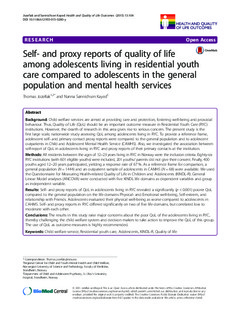| dc.contributor.author | Jozefiak, Thomas | |
| dc.contributor.author | Kayed, Nanna Sønnichsen | |
| dc.date.accessioned | 2015-08-20T08:03:51Z | |
| dc.date.accessioned | 2016-04-22T14:08:12Z | |
| dc.date.available | 2015-08-20T08:03:51Z | |
| dc.date.available | 2016-04-22T14:08:12Z | |
| dc.date.issued | 2015 | |
| dc.identifier.citation | Health and Quality of Life Outcomes 2015, 13(104) | nb_NO |
| dc.identifier.issn | 1477-7525 | |
| dc.identifier.uri | http://hdl.handle.net/11250/2387067 | |
| dc.description.abstract | Background: Child welfare services are aimed at providing care and protection, fostering well-being and prosocial
behaviour. Thus, Quality of Life (QoL) should be an important outcome measure in Residential Youth Care (RYC)
institutions. However, the dearth of research in this area gives rise to serious concern. The present study is the
first large scale, nationwide study assessing QoL among adolescents living in RYC. To provide a reference frame,
adolescent self- and primary contact proxy reports were compared to the general population and to adolescent
outpatients in Child and Adolescent Mental Health Service (CAMHS). Also, we investigated the association between
self-report of QoL in adolescents living in RYC and proxy reports of their primary contacts at the institution.
Methods: All residents between the ages of 12–23 years living in RYC in Norway were the inclusion criteria. Eighty-six
RYC institutions (with 601 eligible youths) were included, 201 youths/ parents did not give their consent. Finally, 400
youths aged 12–20 years participated, yielding a response rate of 67 %. As a reference frame for comparison, a
general population (N = 1444) and an outpatient sample of adolescents in CAMHS (N = 68) were available. We used
the Questionnaire for Measuring Health-related Quality of Life in Children and Adolescents (KINDL-R). General
Linear Model analyses (ANCOVA) were conducted with five KINDL life domains as dependent variables and group
as independent variable.
Results: Self- and proxy reports of QoL in adolescents living in RYC revealed a significantly (p < 0.001) poorer QoL
compared to the general population on the life domains Physical- and Emotional well-being, Self-esteem, and
relationship with Friends. Adolescents evaluated their physical well-being as worse compared to adolescents in
CAHMS. Self- and proxy reports in RYC differed significantly on two of five life domains, but correlated low to
moderate with each other.
Conclusions: The results in this study raise major concerns about the poor QoL of the adolescents living in RYC,
thereby challenging the child welfare system and decision makers to take action to improve the QoL of this group.
The use of QoL as outcome measures is highly recommended. | nb_NO |
| dc.language.iso | eng | nb_NO |
| dc.publisher | BioMed Central | nb_NO |
| dc.rights | Navngivelse 3.0 Norge | * |
| dc.rights.uri | http://creativecommons.org/licenses/by/3.0/no/ | * |
| dc.title | Self- and proxy reports of quality of life among adolescents living in residential youth care compared to adolescents in the general population and mental health services | nb_NO |
| dc.type | Journal article | nb_NO |
| dc.type | Peer reviewed | nb_NO |
| dc.date.updated | 2015-08-20T08:03:51Z | |
| dc.source.volume | 13 | nb_NO |
| dc.source.journal | Health and Quality of Life Outcomes | nb_NO |
| dc.source.issue | 104 | nb_NO |
| dc.identifier.doi | 10.1186/s12955-015-0280-y | |
| dc.identifier.cristin | 1255034 | |
| dc.description.localcode | © Jozefiak and Kayed. 2015. This is an Open Access article distributed under the terms of the Creative Commons Attribution License (http://creativecommons.org/licenses/by/4.0), which permits unrestricted use, distribution, and reproduction in any medium, provided the original work is properly credited. The Creative Commons Public Domain Dedication waiver (http://creativecommons.org/publicdomain/zero/1.0/) applies to the data made available in this article, unless otherwise stated. | nb_NO |

